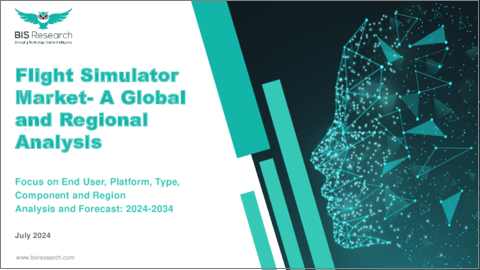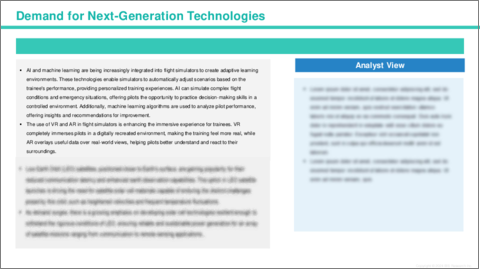|
|
市場調査レポート
商品コード
1510274
フライトシミュレータ市場- 世界および地域別分析:エンドユーザー別、プラットフォーム別、タイプ別、コンポーネント別、地域別 - 分析と予測(2024年~2034年)Flight Simulator Market - A Global and Regional Analysis: Focus on End User, Platform, Type, Component and Region - Analysis and Forecast, 2024-2034 |
||||||
カスタマイズ可能
|
|||||||
| フライトシミュレータ市場- 世界および地域別分析:エンドユーザー別、プラットフォーム別、タイプ別、コンポーネント別、地域別 - 分析と予測(2024年~2034年) |
|
出版日: 2024年07月10日
発行: BIS Research
ページ情報: 英文 100 Pages
納期: 1~5営業日
|
全表示
- 概要
- 目次
フライトシミュレータの市場規模は、様々な要因や市場促進要因に後押しされ、大きな成長を遂げています。
楽観的シナリオでは、市場は2024年に87億7,000万米ドルとなりれ、今後は7.06%のCAGRで拡大し、2034年には173億4,000万米ドルに達すると予測されています。
| 主要市場統計 | |
|---|---|
| 予測期間 | 2024年~2034年 |
| 2024年の評価 | 87億7,000万米ドル |
| 2034年の予測 | 173億4,000万米ドル |
| CAGR | 7.06% |
この成長の主な原動力は、仮想現実と拡張現実技術の進歩、よりダイナミックなシナリオのための人工知能の統合、費用対効果の高い訓練ソリューションへの注目の高まりです。こうした技術シフトにより、より現実的で没入感のある訓練体験が可能になり、民間航空部門と軍事航空部門の両方の進化するニーズに対応しています。さらに、実際の飛行時間への依存を減らすことで、訓練においてより環境的に持続可能な実践を目指す動きが、この変革にさらに拍車をかけています。
フライトシミュレータ市場のもう一つの重要な成長促進要因は、世界の航空交通量の増加によるパイロット訓練需要の高まりです。航空会社が機材を拡大し、新規路線を開設するにつれて、十分な訓練を受けたパイロットの必要性が高まっています。このような需要により、フライトスクールや航空会社は、実機での訓練よりも安全で費用対効果の高いシミュレーションベースの訓練プログラムに多額の投資を行うようになっています。
当レポートでは、世界のフライトシミュレータ市場について調査し、市場の概要とともに、エンドユーザー別、プラットフォーム別、タイプ別、コンポーネント別、地域別の動向、および市場に参入する企業のプロファイルなどを提供しています。
目次
エグゼクティブサマリー
第1章 市場:業界の展望
- 動向:現在および将来の影響評価
- サプライチェーンの概要
- R&Dレビュー
- 規制状況
- ステークホルダー分析
- 市場力学の概要
第2章 フライトシミュレータ市場(用途別)
- 用途のセグメンテーション
- 用途の概要
- フライトシミュレータ市場(エンドユーザー別)
第3章 フライトシミュレータ市場(製品別)
- 製品セグメンテーション
- 製品概要
- フライトシミュレータ市場(プラットフォーム別)
- フライトシミュレータ市場(タイプ別)
- フライトシミュレータ市場(コンポーネント別)
第4章 フライトシミュレータ市場(地域別)
- フライトシミュレータ市場(地域別)
- 北米
- 欧州
- アジア太平洋
- その他の地域
第5章 企業プロファイル
- 今後の見通し
- 地理的評価
- CAE Inc.
- L3Harris Technologies, Inc.
- Flight Safety International
- Thales SA
- Collins Aerospace
- Boeing
- TEXTRON Systems
- RTX
- Airbus S.A.S
- SIMCOM Aviation Training
- FRASCA International,Inc.
- Precision Flight Controls
- Elite Simulation Solutions
- FAAC Incorporated
- SAAB
第6章 調査手法
Introduction to Global Flight Simulator Market
The flight simulator market is undergoing significant growth, propelled by various key factors and market drivers. In an optimistic scenario, the market is evaluated at a valuation of $8.77 billion in 2024 and is projected to expand at a CAGR of 7.06% to reach $17.34 billion by 2034.
| KEY MARKET STATISTICS | |
|---|---|
| Forecast Period | 2024 - 2034 |
| 2024 Evaluation | $8.77 Billion |
| 2034 Forecast | $17.34 Billion |
| CAGR | 7.06% |
A primary driver for this growth is the advancements in virtual and augmented reality technologies, the integration of artificial intelligence for more dynamic scenarios, and an increasing focus on cost-effective training solutions. These technological shifts are allowing for more realistic and immersive training experiences, catering to the evolving needs of both commercial and military aviation sectors. Additionally, the push towards more environmentally sustainable practices in training, by reducing the reliance on actual flight hours, further fuels this transformation.
Another significant driver of growth in the flight simulator market is the rising demand for pilot training due to global increases in air traffic. As airlines expand their fleets and open new routes, the need for well-trained pilots escalates. This demand pushes flight schools and airlines to invest more heavily in simulation-based training programs, which are safer and more cost-effective than training in actual aircraft.
Furthermore, prominent companies such as CAE, Inc., L3Harris Technologies, Inc., Airbus, and Boeing are increasingly investing in innovative solutions to enhance their operational processes and maintain competitive advantage. These investments are focused on integrating cutting-edge technologies such as artificial intelligence, machine learning, and augmented reality into their systems. Such innovations are not only aimed at improving the efficiency and accuracy of their flight simulators but also at reducing costs and expanding training capabilities to meet the growing global demand for skilled aviation professionals.
Overall, the flight simulator market is set for substantial growth, expected to nearly double in value over the next decade, driven by technological innovations including VR, AR, and AI that enhance the realism and effectiveness of training. This growth is also supported by a rising need for pilots due to global aviation expansion and a shift towards more sustainable training practices. Together, these factors ensure that flight simulators remain crucial in preparing the next generation of pilots in both the commercial and military sectors.
Market Segmentation:
Segmentation 1: by End User
- Commercial
- Military and Defense
- Others
Segmentation 2: by Platform
- Commercial Aviation
- Military Aircraft
- Unmanned Aerial Vehicle (UAV)
Segmentation 3: by Type
- Full Flight Simulators
- Fixed Base Simulators
- Flight Training Devices
- Full Mission Flight Simulators
Segmentation 4: by Component
- Hardware
- Software
- Services
Segmentation 5: by Region
- North America
- Europe
- Asia-Pacific
- Rest-of-the-World
How can this report add value to an organization?
Product/Innovation Strategy: The global flight simulator market has been extensively segmented based on various categories, such as platform, type, component, and end user. This can help readers get a clear overview of which segments account for the largest share and which ones are well-positioned to grow in the coming years.
Competitive Strategy: A detailed competitive benchmarking of the players operating in the global flight simulator market has been done to help the reader understand how players stack against each other, presenting a clear market landscape. Additionally, comprehensive competitive strategies such as partnerships, agreements, and collaborations will aid the reader in understanding the untapped revenue pockets in the market.
Key Market Players and Competition Synopsis
The companies that are profiled have been selected based on thorough secondary research, which includes analyzing company coverage, product portfolio, market penetration, and insights gathered from primary experts.
Some of the prominent companies in this market are:
- CAE Inc.
- L3Harris Technologies, Inc.
- Thales SA
- Flight Safety International
- Boeing
- Airbus S.A.S
Key Questions Answered in this Report:
- What are the main factors driving the demand for global flight simulator market?
- What are the major patents filed by the companies active in the flight simulator market?
- Who are the key players in the global flight simulator market, and what are their respective market shares?
- What partnerships or collaborations are prominent among stakeholders in the global flight simulator market?
- What are the strategies adopted by the key companies to gain a competitive edge in global flight simulator market?
- What is the futuristic outlook for the flight simulator market in terms of growth potential?
- What is the current estimation of the global flight simulator market and what growth trajectory is projected from 2024 to 2034?
- Which application, and product segment is expected to lead the market over the forecast period (2024-2034)?
- Which regions demonstrate the highest adoption rates for global flight simulator market, and what factors contribute to their leadership?
Table of Contents
Executive Summary
Scope and Definition
Market/Product Definition
Key Questions Answered
Analysis and Forecast Note
1. Markets: Industry Outlook
- 1.1 Trends: Current and Future Impact Assessment
- 1.2 Supply Chain Overview
- 1.2.1 Value Chain Analysis
- 1.2.2 Pricing Forecast
- 1.3 R&D Review
- 1.3.1 Patent Filing Trend by Country, by Company
- 1.4 Regulatory Landscape
- 1.5 Stakeholder Analysis
- 1.5.1 Use Case
- 1.5.2 End User and Buying Criteria
- 1.6 Market Dynamics Overview
- 1.6.1 Market Drivers
- 1.6.2 Market Restraints
- 1.6.3 Market Opportunities
2. Flight Simulator Market (by Application)
- 2.1 Application Segmentation
- 2.2 Application Summary
- 2.3 Flight Simulator Market (by End User)
- 2.3.1 Commercial
- 2.3.2 Military and Defense
- 2.3.3 Others
3. Flight Simulator Market (by Products)
- 3.1 Product Segmentation
- 3.2 Product Summary
- 3.3 Flight Simulator Market (by Platform)
- 3.3.1 Commercial Aviation
- 3.3.1.1 Narrow- Body Aircraft
- 3.3.1.2 Regional Transport Aircraft
- 3.3.1.3 Wide-Body Aircraft
- 3.3.1.4 Extra Wide-Body Aircraft
- 3.3.2 Military Aircraft
- 3.3.2.1 Transport Aircraft
- 3.3.2.2 Training Aircraft
- 3.3.2.3 Special Aircraft
- 3.3.2.4 Helicopters
- 3.3.3 Unmanned Aerial Vehicle (UAV)
- 3.3.1 Commercial Aviation
- 3.4 Flight Simulator Market (by Type)
- 3.4.1 Full Flight Simulators
- 3.4.2 Fixed Base Simulators
- 3.4.3 Flight Training Devices
- 3.4.4 Full Mission Flight Simulators
- 3.5 Flight Simulator Market (by Component)
- 3.5.1 Hardware
- 3.5.2 Software
- 3.5.3 Services
4. Flight Simulator Market (by Region)
- 4.1 Flight Simulator Market (by Region)
- 4.2 North America
- 4.2.1 Regional Overview
- 4.2.2 Driving Factors for Market Growth
- 4.2.3 Factors Challenging the Market
- 4.2.4 Application
- 4.2.5 Product
- 4.2.6 U.S.
- 4.2.6.1 Market by Application
- 4.2.6.2 Market by Product
- 4.2.7 Canada
- 4.2.7.1 Market by Application
- 4.2.7.2 Market by Product
- 4.2.8 Mexico
- 4.2.8.1 Market by Application
- 4.2.8.2 Market by Product
- 4.3 Europe
- 4.3.1 Regional Overview
- 4.3.2 Driving Factors for Market Growth
- 4.3.3 Factors Challenging the Market
- 4.3.4 Application
- 4.3.5 Product
- 4.3.6 Germany
- 4.3.6.1 Market by Application
- 4.3.6.2 Market by Product
- 4.3.7 France
- 4.3.7.1 Market by Application
- 4.3.7.2 Market by Product
- 4.3.8 U.K.
- 4.3.8.1 Market by Application
- 4.3.8.2 Market by Product
- 4.3.9 Italy
- 4.3.9.1 Market by Application
- 4.3.9.2 Market by Product
- 4.3.10 Rest-of-Europe
- 4.3.10.1 Market by Application
- 4.3.10.2 Market by Product
- 4.4 Asia-Pacific
- 4.4.1 Regional Overview
- 4.4.2 Driving Factors for Market Growth
- 4.4.3 Factors Challenging the Market
- 4.4.4 Application
- 4.4.5 Product
- 4.4.6 China
- 4.4.6.1 Market by Application
- 4.4.6.2 Market by Product
- 4.4.7 Japan
- 4.4.7.1 Market by Application
- 4.4.7.2 Market by Product
- 4.4.8 India
- 4.4.8.1 Market by Application
- 4.4.8.2 Market by Product
- 4.4.9 South Korea
- 4.4.9.1 Market by Application
- 4.4.9.2 Market by Product
- 4.4.10 Rest-of-Asia-Pacific
- 4.4.10.1 Market by Application
- 4.4.10.2 Market by Product
- 4.5 Rest-of-the-World
- 4.5.1 Regional Overview
- 4.5.2 Driving Factors for Market Growth
- 4.5.3 Factors Challenging the Market
- 4.5.4 Application
- 4.5.5 Product
- 4.5.6 South America
- 4.5.6.1 Market by Application
- 4.5.6.2 Market by Product
- 4.5.7 Middle East and Africa
- 4.5.7.1 Market by Application
- 4.5.7.2 Market by Product
5. Companies Profiled
- 5.1 Next Frontiers
- 5.2 Geographic Assessment
- 5.2.1 CAE Inc.
- 5.2.1.1 Overview
- 5.2.1.2 Top Products/Product Portfolio
- 5.2.1.3 Top Competitors
- 5.2.1.4 Target Customers
- 5.2.1.5 Key Personnel
- 5.2.1.6 Analyst View
- 5.2.1.7 Market Share
- 5.2.2 L3Harris Technologies, Inc.
- 5.2.2.1 Overview
- 5.2.2.2 Top Products/Product Portfolio
- 5.2.2.3 Top Competitors
- 5.2.2.4 Target Customers
- 5.2.2.5 Key Personnel
- 5.2.2.6 Analyst View
- 5.2.2.7 Market Share
- 5.2.3 Flight Safety International
- 5.2.3.1 Overview
- 5.2.3.2 Top Products/Product Portfolio
- 5.2.3.3 Top Competitors
- 5.2.3.4 Target Customers
- 5.2.3.5 Key Personnel
- 5.2.3.6 Analyst View
- 5.2.3.7 Market Share
- 5.2.4 Thales SA
- 5.2.4.1 Overview
- 5.2.4.2 Top Products/Product Portfolio
- 5.2.4.3 Top Competitors
- 5.2.4.4 Target Customers
- 5.2.4.5 Key Personnel
- 5.2.4.6 Analyst View
- 5.2.4.7 Market Share
- 5.2.5 Collins Aerospace
- 5.2.5.1 Overview
- 5.2.5.2 Top Products/Product Portfolio
- 5.2.5.3 Top Competitors
- 5.2.5.4 Target Customers
- 5.2.5.5 Key Personnel
- 5.2.5.6 Analyst View
- 5.2.5.7 Market Share
- 5.2.6 Boeing
- 5.2.6.1 Overview
- 5.2.6.2 Top Products/Product Portfolio
- 5.2.6.3 Top Competitors
- 5.2.6.4 Target Customers
- 5.2.6.5 Key Personnel
- 5.2.6.6 Analyst View
- 5.2.6.7 Market Share
- 5.2.7 TEXTRON Systems
- 5.2.7.1 Overview
- 5.2.7.2 Top Products/Product Portfolio
- 5.2.7.3 Top Competitors
- 5.2.7.4 Target Customers
- 5.2.7.5 Key Personnel
- 5.2.7.6 Analyst View
- 5.2.7.7 Market Share
- 5.2.8 RTX
- 5.2.8.1 Overview
- 5.2.8.2 Top Products/Product Portfolio
- 5.2.8.3 Top Competitors
- 5.2.8.4 Target Customers
- 5.2.8.5 Key Personnel
- 5.2.8.6 Analyst View
- 5.2.8.7 Market Share
- 5.2.9 Airbus S.A.S
- 5.2.9.1 Overview
- 5.2.9.2 Top Products/Product Portfolio
- 5.2.9.3 Top Competitors
- 5.2.9.4 Target Customers
- 5.2.9.5 Key Personnel
- 5.2.9.6 Analyst View
- 5.2.9.7 Market Share
- 5.2.10 SIMCOM Aviation Training
- 5.2.10.1 Overview
- 5.2.10.2 Top Products/Product Portfolio
- 5.2.10.3 Top Competitors
- 5.2.10.4 Target Customers
- 5.2.10.5 Key Personnel
- 5.2.10.6 Analyst View
- 5.2.10.7 Market Share
- 5.2.11 FRASCA International,Inc.
- 5.2.11.1 Overview
- 5.2.11.2 Top Products/Product Portfolio
- 5.2.11.3 Top Competitors
- 5.2.11.4 Target Customers
- 5.2.11.5 Key Personnel
- 5.2.11.6 Analyst View
- 5.2.11.7 Market Share
- 5.2.12 Precision Flight Controls
- 5.2.12.1 Overview
- 5.2.12.2 Top Products/Product Portfolio
- 5.2.12.3 Top Competitors
- 5.2.12.4 Target Customers
- 5.2.12.5 Key Personnel
- 5.2.12.6 Analyst View
- 5.2.12.7 Market Share
- 5.2.13 Elite Simulation Solutions
- 5.2.13.1 Overview
- 5.2.13.2 Top Products/Product Portfolio
- 5.2.13.3 Top Competitors
- 5.2.13.4 Target Customers
- 5.2.13.5 Key Personnel
- 5.2.13.6 Analyst View
- 5.2.13.7 Market Share
- 5.2.14 FAAC Incorporated
- 5.2.14.1 Overview
- 5.2.14.2 Top Products/Product Portfolio
- 5.2.14.3 Top Competitors
- 5.2.14.4 Target Customers
- 5.2.14.5 Key Personnel
- 5.2.14.6 Analyst View
- 5.2.14.7 Market Share
- 5.2.15 SAAB
- 5.2.15.1 Overview
- 5.2.15.2 Top Products/Product Portfolio
- 5.2.15.3 Top Competitors
- 5.2.15.4 Target Customers
- 5.2.15.5 Key Personnel
- 5.2.15.6 Analyst View
- 5.2.15.7 Market Share
- 5.2.1 CAE Inc.





